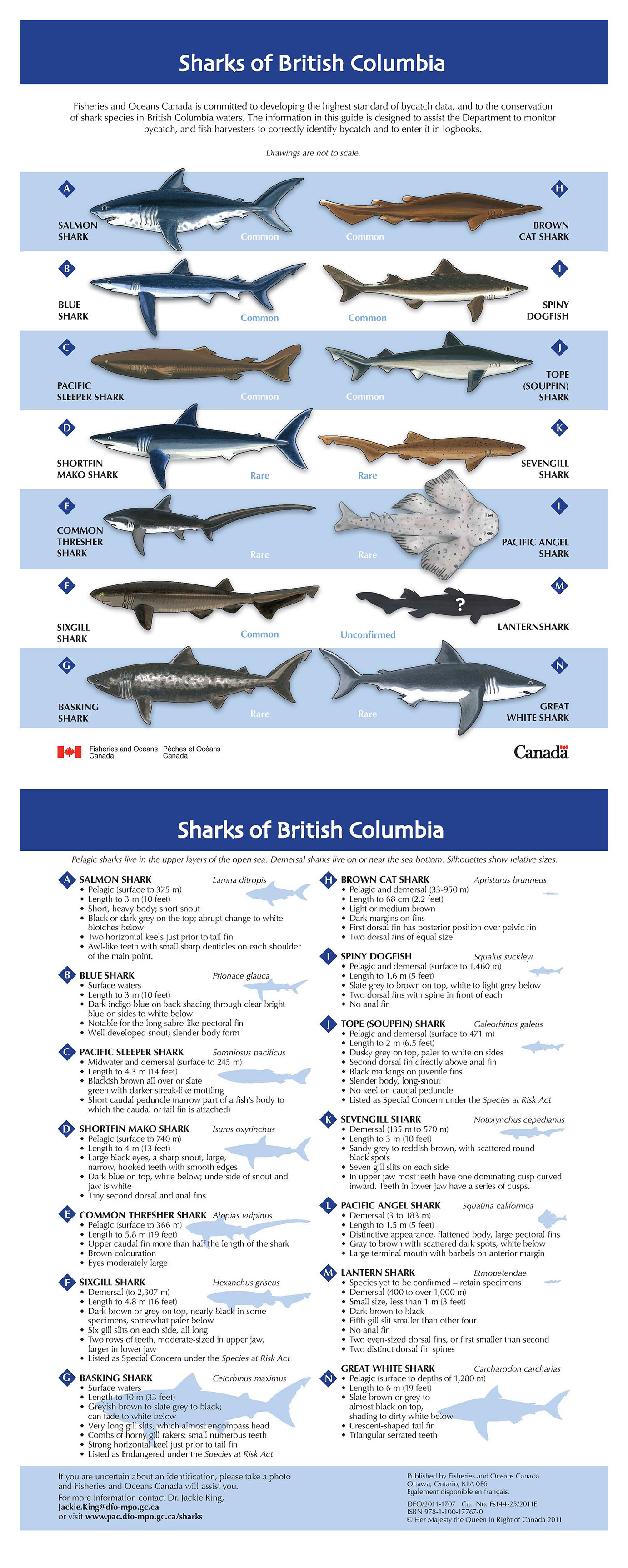Sharks of British Columbia

Description: Sharks of British Columbia
Sharks of British Columbia
Fisheries and Oceans Canada is committed to developing the highest standard of bycatch data, and to the conservation of shark species in British Columbia waters. The information in this guide is designed to assist the Department to monitor bycatch, and fish harvesters to correctly identify bycatch and to enter it in logbooks.
- Salmon shark — Common
- Blue shark — Common
- Pacific sleeper shark — Common
- Shortfin mako shark — Rare
- Common thresher shark — Rare
- Sixgill shark — Common
- Basking shark — Rare
- Brown cat shark — Common
- Spiny dogfish — Common
- Tope (Soupfin) shark — Common
- Sevengill shark — Rare
- Pacific angel shark — Rare
- Lantern shark — Unconfirmed
- Great white shark — Rare
Pelagic sharks live in the upper layers of the open sea. Demersal sharks live on or near the sea bottom. Silhouettes show relative sizes.
- Salmon shark (Lamna ditropis)
- Pelagic (surface to 375 m)
- Length to 3 m (10 feet)
- Short, heavy body; short snout
- Black or dark grey on the top; abrupt change to white blotches below
- Two horizontal keels just prior to tail fin
- Awl-like teeth with small sharp denticles on each shoulder of the main point.
- Blue shark (Prionace glauca)
- Surface waters
- Length to 3 m (10 feet)
- Dark indigo blue on back shading through clear bright blue on sides to white below
- Notable for the long sabre-like pectoral fin
- Well developed snout; slender body form
- Pacific sleeper shark (Somniosus pacificus)
- Midwater and demersal (surface to 245 m)
- Length to 4.3 m (14 feet)
- Blackish brown all over or slate green with darker streak-like mottling
- Short caudal peduncle (narrow part of a fish)
- Shortfin mako shark (Isurus oxyrinchus)
- Pelagic (surface to 740 m)
- Length to 4 m (13 feet)
- Large black eyes, a sharp snout, large, narrow, hooked teeth with smooth edges
- Dark blue on top, white below; underside of snout and jaw is white
- Tiny second dorsal and anal fins
- Common thresher shark (Alopias vulpinus)
- Pelagic (surface to 366 m)
- Length to 5.8 m (19 feet)
- Upper caudal fin more than half the length of the shark
- Brown colouration
- Eyes moderately large
- Sixgill shark (Hexanchus griseus)
- Demersal (to 2,307 m)
- Length to 4.8 m (16 feet)
- Dark brown or grey on top, nearly black in some specimens, somewhat paler below
- Six gill slits on each side, all long
- Two rows of teeth, moderate-sized in upper jaw, larger in lower jaw
- Listed as Special Concern under the Species at Risk Act
- Basking shark (Cetorhinus maximus)
- Surface waters
- Length to 10 m (33 feet)
- Greyish brown to slate grey to black; can fade to white below
- Very long gill slits, which almost encompass head
- Combs of horny gill rakers; small numerous teeth
- Strong horizontal keel just prior to tail fin
- Listed as Endangered under the Species at Risk Act
- Brown cat shark (Apristurus brunneus)
- Pelagic and demersal (33-950 m)
- Length to 68 cm (2.2 feet)
- Light or medium brown
- Dark margins on fins
- First dorsal fin has posterior position over pelvic fin
- Two dorsal fins of equal size
- Spiny dogfish (Squalus suckleyi)
- Pelagic and demersal (surface to 1,460 m)
- Length to 1.6 m (5 feet)
- Slate grey to brown on top, white to light grey below
- Two dorsal fins with spine in front of each
- No anal fin
- Tope (Soupfin) shark (Galeorhinus galeus)
- Pelagic and demersal (surface to 471 m)
- Length to 2 m (6.5 feet)
- Dusky grey on top, paler to white on sides
- Second dorsal fin directly above anal fin
- Black markings on juvenile fins
- Slender body, long-snout
- No keel on caudal peduncle
- Listed as Special Concern under the Species at Risk Act
- Sevengill shark (Notorynchus cepedianus)
- Demersal (135 m to 570 m)
- Length to 3 m (10 feet)
- Sandy grey to reddish brown, with scattered round black spots
- Seven gill slits on each side
- In upper jaw most teeth have one dominating cusp curved inward. Teeth in lower jaw have a series of cusps.
- Pacific angel shark (Squatina californica)
- Demersal (3 to 183 m)
- Length to 1.5 m (5 feet)
- Distinctive appearance, flattened body, large pectoral fins
- Gray to brown with scattered dark spots, white below
- Large terminal mouth with barbels on anterior margin
- Lantern shark (Etmopeteridae)
- Species yet to be confirmed – retain specimens
- Demersal (400 to over 1,000 m)
- Small size, less than 1 m (3 feet)
- Dark brown to black
- Fifth gill slit smaller than other four
- No anal fin
- Two even-sized dorsal fins, or first smaller than second
- Two distinct dorsal fin spines
- Great white shark (Carcharodon carcharias)
- Pelagic (surface to depths of 1,280 m)
- Length to 6 m (19 feet)
- Slate brown or grey to almost black on top, shading to dirty white below
- Crescent-shaped tail fin
- Triangular serrated teeth
If you are uncertain about an identification, please take a photo and Fisheries and Oceans Canada will assist you.
For more information contact Dr. Jackie King, Jackie.King@dfo-mpo.gc.ca, or visit Pacific marine mammals and sharks.
Published by Fisheries and Oceans Canada
Ottawa, Ontario, K1A 0E6
Également disponible en français.
DFO/2011-1707 Cat. No. Fs144-25/2011E
ISBN 978-1-100-17767-0
© Her Majesty the Queen in Right of Canada 2011
- Date modified: